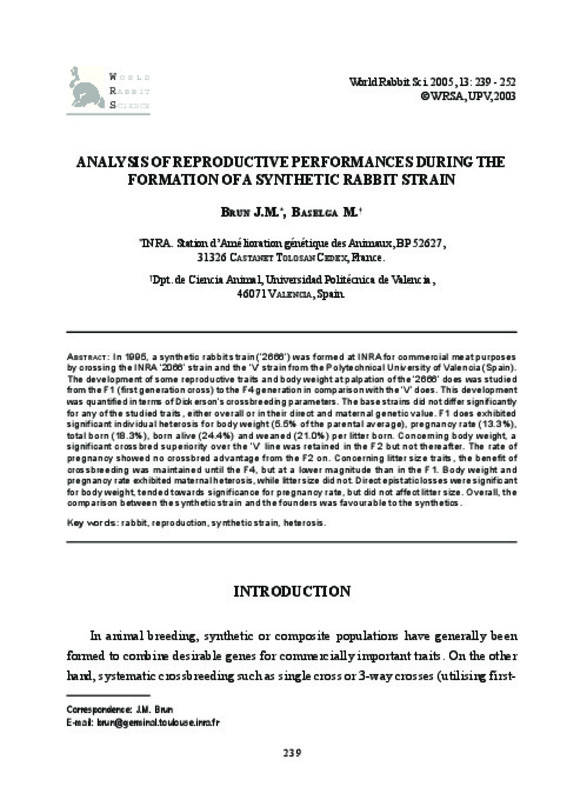JavaScript is disabled for your browser. Some features of this site may not work without it.
Buscar en RiuNet
Listar
Mi cuenta
Estadísticas
Ayuda RiuNet
Admin. UPV
Analysis of reproductive performances during the formation of a synthetic rabbit strain
Mostrar el registro sencillo del ítem
Ficheros en el ítem
| dc.contributor.author | Brun, J.M.
|
|
| dc.contributor.author | Baselga, M.
|
|
| dc.date.accessioned | 2011-02-11T12:13:21Z | |
| dc.date.available | 2011-02-11T12:13:21Z | |
| dc.date.issued | 2005 | |
| dc.identifier.issn | 1257-5011 | |
| dc.identifier.uri | http://hdl.handle.net/10251/9699 | |
| dc.description.abstract | [EN] In 1995, a synthetic rabbit strain ('2666') was formed at INRA for commercial meat purposesby crossing the INRA '2066' strain and the 'V' strain from the Polytechnical University of Valencia (Spain).The development of some reproductive traits and body weight at palpation of the '2666' does was studiedfrom the F1 (first generation cross) to the F4 generation in comparison with the 'V' does. This developmentwas quantified in terms of Dickerson's crossbreeding parameters. The base strains did not differ significantlyfor any of the studied traits, either overall or in their direct and maternal genetic value. F1 does exhibitedsignificant individual heterosis for body weight (5.5% of the parental average), pregnancy rate (13.3%),total born (18.3%), born alive (24.4%) and weaned (21.0%) per litter born. Concerning body weight, asignificant crossbred superiority over the 'V' line was retained in the F2 but not thereafter. The rate ofpregnancy showed no crossbred advantage from the F2 on. Concerning litter size traits, the benefit ofcrossbreeding was maintained until the F4, but at a lower magnitude than in the F1. Body weight andpregnancy rate exhibited maternal heterosis, while litter size did not. Direct epistatic losses were significantfor body weight, tended towards significance for pregnancy rate, but did not affect litter size. Overall, thecomparison between the synthetic strain and the founders was favourable to the synthetics. | es_ES |
| dc.language | Inglés | es_ES |
| dc.publisher | World Rabbit Science. ICTA. UPV | es_ES |
| dc.relation.ispartof | World Rabbit Science | |
| dc.rights | Reserva de todos los derechos | es_ES |
| dc.subject | Rabbit | es_ES |
| dc.subject | Reproduction | es_ES |
| dc.subject | Synthetic strain | es_ES |
| dc.subject | Heterosis | es_ES |
| dc.title | Analysis of reproductive performances during the formation of a synthetic rabbit strain | es_ES |
| dc.type | Artículo | es_ES |
| dc.date.updated | 2011-02-11T11:16:45Z | |
| dc.identifier.doi | 10.4995/wrs.2005.514 | |
| dc.rights.accessRights | Abierto | es_ES |
| dc.description.bibliographicCitation | Brun, J.; Baselga, M. (2005). Analysis of reproductive performances during the formation of a synthetic rabbit strain. World Rabbit Science. 13. https://doi.org/10.4995/wrs.2005.514 | es_ES |
| dc.description.accrualMethod | SWORD | es_ES |
| dc.relation.publisherversion | https://doi.org/10.4995/wrs.2005.514 | es_ES |
| dc.description.volume | 13 | |
| dc.identifier.eissn | 1989-8886 | es_ES |








